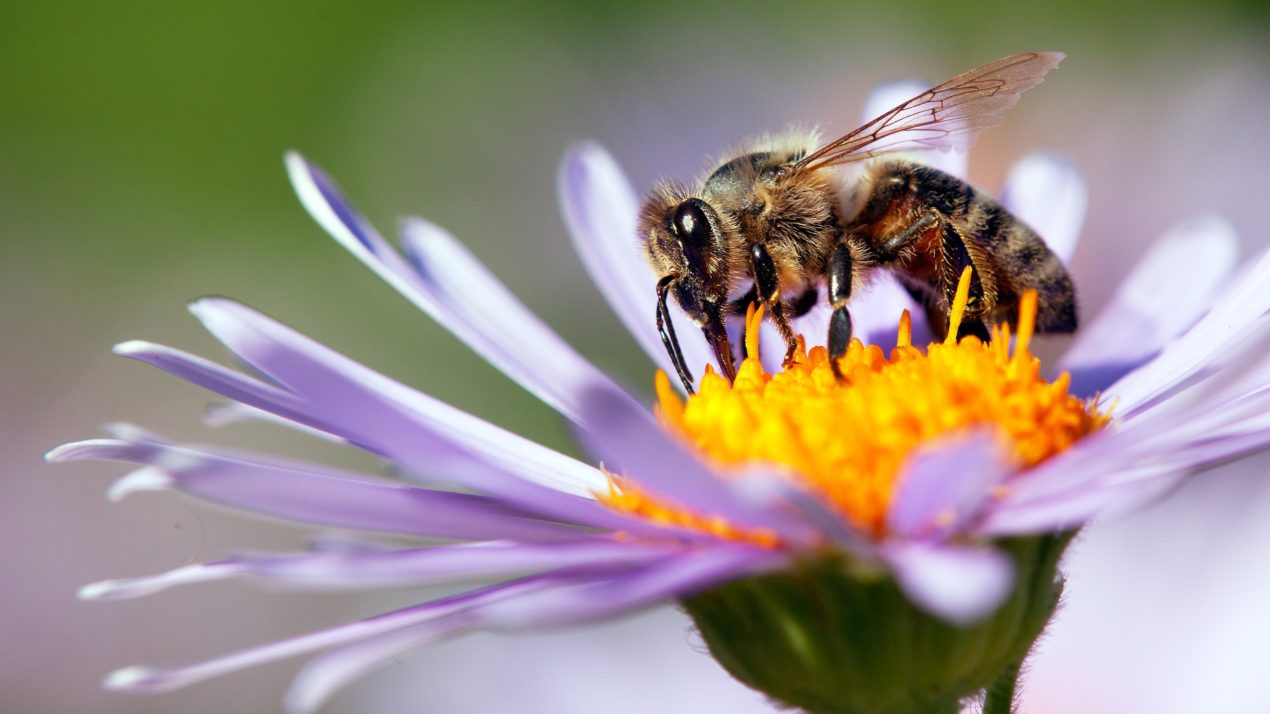
On a warm summer day in Wisconsin, bees across the state are hard at work collecting pollen and nectar for their livelihoods. Hopping from flower to flower in crop fields, prairie parcels and woodlands, some of these beneficial insects are under surprisingly close scrutiny. Around the state, growers, gardeners, researchers and others—with cell phones in hand—are using a mobile app to track the bees they observe and their flower visitations.
The app, called WiBee: The Wisconsin Wild Bee App, is the key tool for a new citizen science project to observe and collect high-quality data on the abundance, diversity and activity of wild bees in the state. It was launched last year by a research team led by Claudio Gratton, a professor in the University of Wisconsin–Madison Department of Entomology, with funding from the Ira and Ineva Reilly Baldwin Wisconsin Idea Endowment and Gwenyn Hill Farm.
“The project started with apple growers reaching out to the Gratton lab asking whether they need honeybees on their property, or if they could rely on wild bees instead,” explains Colleen Satyshur, outreach specialist for the WiBee project. “It costs money to rent honeybee hives and there’s coordination involved, so [the growers wanted to figure out if] they had enough wild bees around to pollinate their apples.”
More than one-third of the planet’s food crops depend on pollination, and bees are the most efficient pollinators in many cases. In Wisconsin, bees are essential to many of the state’s fruit and vegetable crops such as cranberries, cherries, melons and squash.
In Wisconsin, like elsewhere, many growers rely on European honeybees for pollination services. Yet the state has over 400 species of native, wild bees that may be able to help do the job. The extent to which they can help, however, is unknown. It’s the goal of the WiBee project to collect the data needed to monitor trends in wild bee communities, share recommendations on pollination management, and eventually help bolster native bee populations.
“For growers and farmers, the app provides a tool for them to track their own pollination and start to make evidence-based decisions depending on the pollination they are seeing on their own properties,” says Satyshur. “And when the full data analysis comes out we will have more specific recommendations as well.”
The WiBee app collects bee visitation data through user surveys. Each survey takes five minutes to conduct and involves users watching bees as they visit flowers in a three-by-three foot area. Since bee behavior is highly influenced by time of day, weather or even just a single cloud passing over, large quantities of data—including repeat surveys at the same locations—are needed to be able to develop pollination management recommendations.
“Bees fluctuate a lot between years, within a season and among farms, so it is hard to get a simple view of what bee communities look like on farms with only casual observations,” explains Gratton. “This is like trying to predict if the tide is going in or out by looking at the waves on the shore for one minute. You need long-term, consistent data to see trends. This is one of the things that WiBee will help with as more and more observations are made.”
Preliminary results from the project show that a given farm or orchard is likely to have more wild bee visits if it is in a landscape with more woodlands, wetlands, or urban development nearby. When it comes to apple orchards, they found a lot of variation—including some promising numbers.
“Our data show that some orchards appear to have suffient pollination from wild bees, according to the [established threshold],” says Satyshur.
In 2020, 116 app users conducted 891 surveys in total, and things are on track to at least double this amount in 2021. The most well-represented crop plants so far include apple, cranberry and cucurbits. Wildflower and ornamental flower data has been coming in from Wisconsin Master Gardener Volunteers and other users. Satyshur notes the project still needs more data of all kinds from around the state, but particularly for berry crops and tomatoes, and she encourages interested individuals to download and try the app.
It’s exciting for Satyshur to see the growing interest in the WiBee app, as she believes it may encourage people to consider implementing pollinator-friendly practices such as reducing pesticides and planting pollinator gardens, actions that can help support important agricultural and ecological goals. Another positive outcome of the app is that it encourages people to “stop and smell the flowers”—as they observe the bees.
“There are so many different kinds of bees out there,” says Satyshur. “Once you look at them, it’s really neat. There’s so much to see in them.”
For more information about the WiBee app, visit https://pollinators.wisc.edu/wibee/.
Five ways you can help Wisconsin’s wild bees:
- Download the WiBee app to learn about Wisconsin’s wild bees and help collect data.
- Assess the “bee friendliness” of your property at https://pollinators.wisc.edu/habitat/.
- Keep a part of your yard “messy:” Leaving around dead wood or brush can provide habitat for cavity-nesting bees.
- Skip the wood mulch in spots: Some bees nest in the ground and can’t do that under a layer of wood mulch.
- Minimize pesticide use in your yard.

